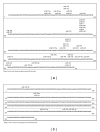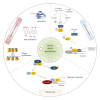Health promoting effects of brassica-derived phytochemicals: from chemopreventive and anti-inflammatory activities to epigenetic regulation
- PMID: 24454992
- PMCID: PMC3885109
- DOI: 10.1155/2013/964539
Health promoting effects of brassica-derived phytochemicals: from chemopreventive and anti-inflammatory activities to epigenetic regulation
Abstract
A high intake of brassica vegetables may be associated with a decreased chronic disease risk. Health promoting effects of Brassicaceae have been partly attributed to glucosinolates and in particular to their hydrolyzation products including isothiocyanates. In vitro and in vivo studies suggest a chemopreventive activity of isothiocyanates through the redox-sensitive transcription factor Nrf2. Furthermore, studies in cultured cells, in laboratory rodents, and also in humans support an anti-inflammatory effect of brassica-derived phytochemicals. However, the underlying mechanisms of how these compounds mediate their health promoting effects are yet not fully understood. Recent findings suggest that brassica-derived compounds are regulators of epigenetic mechanisms. It has been shown that isothiocyanates may inhibit histone deacetylase transferases and DNA-methyltransferases in cultured cells. Only a few papers have dealt with the effect of brassica-derived compounds on epigenetic mechanisms in laboratory animals, whereas data in humans are currently lacking. The present review aims to summarize the current knowledge regarding the biological activities of brassica-derived phytochemicals regarding chemopreventive, anti-inflammatory, and epigenetic pathways.
Figures






Similar articles
-
Brassica-Derived Plant Bioactives as Modulators of Chemopreventive and Inflammatory Signaling Pathways.Int J Mol Sci. 2017 Sep 1;18(9):1890. doi: 10.3390/ijms18091890. Int J Mol Sci. 2017. PMID: 28862664 Free PMC article. Review.
-
Chemical Aspects of Biological Activity of Isothiocyanates and Indoles, the Products of Glucosinolate Decomposition.Curr Pharm Des. 2019;25(15):1717-1728. doi: 10.2174/1381612825666190701151644. Curr Pharm Des. 2019. PMID: 31267852 Review.
-
Plant phytochemicals as epigenetic modulators: role in cancer chemoprevention.AAPS J. 2014 Jan;16(1):151-63. doi: 10.1208/s12248-013-9548-5. Epub 2013 Dec 5. AAPS J. 2014. PMID: 24307610 Free PMC article. Review.
-
Brassica Bioactives Could Ameliorate the Chronic Inflammatory Condition of Endometriosis.Int J Mol Sci. 2020 Dec 10;21(24):9397. doi: 10.3390/ijms21249397. Int J Mol Sci. 2020. PMID: 33321760 Free PMC article. Review.
-
Analysis of the anti-inflammatory potential of Brassica bioactive compounds in a human macrophage-like cell model derived from HL-60 cells.Biomed Pharmacother. 2022 May;149:112804. doi: 10.1016/j.biopha.2022.112804. Epub 2022 Mar 10. Biomed Pharmacother. 2022. PMID: 35279599
Cited by
-
Nutraceutical Improvement Increases the Protective Activity of Broccoli Sprout Juice in a Human Intestinal Cell Model of Gut Inflammation.Pharmaceuticals (Basel). 2016 Aug 12;9(3):48. doi: 10.3390/ph9030048. Pharmaceuticals (Basel). 2016. PMID: 27529258 Free PMC article.
-
Selenium Biofortification in Radish Enhances Nutritional Quality via Accumulation of Methyl-Selenocysteine and Promotion of Transcripts and Metabolites Related to Glucosinolates, Phenolics, and Amino Acids.Front Plant Sci. 2016 Sep 14;7:1371. doi: 10.3389/fpls.2016.01371. eCollection 2016. Front Plant Sci. 2016. PMID: 27683583 Free PMC article.
-
Extraction of Bioactive Compounds from Different Vegetable Sprouts and Their Potential Role in the Formulation of Functional Foods against Various Disorders: A Literature-Based Review.Molecules. 2022 Oct 28;27(21):7320. doi: 10.3390/molecules27217320. Molecules. 2022. PMID: 36364145 Free PMC article. Review.
-
Glucosinolate-Degradation Products as Co-Adjuvant Therapy on Prostate Cancer in Vitro.Int J Mol Sci. 2019 Oct 9;20(20):4977. doi: 10.3390/ijms20204977. Int J Mol Sci. 2019. PMID: 31600887 Free PMC article.
-
In Silico and In Vitro Analysis of Sulforaphane Anti-Candida Activity.Antibiotics (Basel). 2022 Dec 19;11(12):1842. doi: 10.3390/antibiotics11121842. Antibiotics (Basel). 2022. PMID: 36551499 Free PMC article.
References
-
- Verhoeven DTH, Goldbohm RA, Van Poppel G, Verhagen H, Van Den Brandt PA. Epidemiological studies on Brassica vegetables and cancer risk. Cancer Epidemiology Biomarkers and Prevention. 1996;5(9):733–748. - PubMed
-
- Verhoeven DTH, Verhagen H, Goldbohm RA, Van Den Brandt PA, Van Poppel G. A review of mechanisms underlying anticarcinogenicity by brassica vegetables. Chemico-Biological Interactions. 1997;103(2):79–129. - PubMed
-
- Voorrips LE, Goldbohm RA, Van Poppel G, Sturmans F, Hermus RJJ, Van Den Brandt PA. Vegetable and fruit consumption and risks of colon and rectal cancer in a prospective cohort study: the Netherlands Cohort Study on Diet and Cancer. American Journal of Epidemiology. 2000;152(11):1081–1092. - PubMed
-
- Dinkova-Kostova AT, Kostov RV. Glucosinolates and isothiocyanates in health and disease. Trends in Molecular Medicine. 2012;18:337–347. - PubMed
-
- Melchini A, Costa C, Traka M, et al. Erucin, a new promising cancer chemopreventive agent from rocket salads, shows anti-proliferative activity on human lung carcinoma A549 cells. Food and Chemical Toxicology. 2009;47(7):1430–1436. - PubMed
Publication types
MeSH terms
Substances
LinkOut - more resources
Full Text Sources
Other Literature Sources

